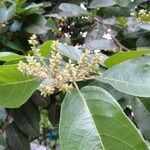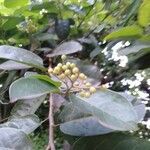A stout and erect tree. It grows 3-8 m tall and spreads 2-4 m across. The trunk is covered with chalky yellowish brown bark. It is rough and mottled. The timber is light coloured and hard. The young branches and new leaves have woolly hairs. The tree loses its leaves during the dry season. The leaves are 3-7.5 cm long by 2-3 cm wide. They are broadly oval with a blunt tip. The leaves are thinly textured and shiny on the upper surface but paler underneath. The leaves are numerous. The flowers are numerous and densely clustered. Male and female flowers occur on separate trees. The male flower spikes are 2.5-5 cm long and the female flowers are on short thick stalks at the ends of branches. The individual flowers are very small and about 1-2 mm long. The fruit are small, oval and fleshy. They are 0.4-0.6 cm long and purple when ripe. The fruit are edible.
Subshrub, shrub or small tree to 6 m high, deciduous. Stipules lanceolate, 1–2 mm long. Leaves: petiole 2–11 mm long; lamina elliptic, oblong or ovate, 13–90 long, 9–50 mm wide, base cordate, cuneate or rounded, margin entire or weakly sinuate, tip acute, obtuse or rounded, lateral veins mostly 7 or 8. Male flowers 2.8–3 mm long; calyx cupular, 0.5–0.8 mm long; disc with dense hairs; stamens 4 or 5. Female flowers 1.5–3.5 mm long; pedicel 0.6–2 mm long; calyx 5-lobed, with lobes ovate, 0.7–1.8 mm long; disc annular, glabrous; styles 3, recurved, terminal, 0.8–1 mm long. Fruit flattened-ellipsoid, purple-black to purple-red, 4.5–8 mm long, 4–8 mm diam.



